Please select root levels for the menu
NZ Plants
Pine Life Cycle
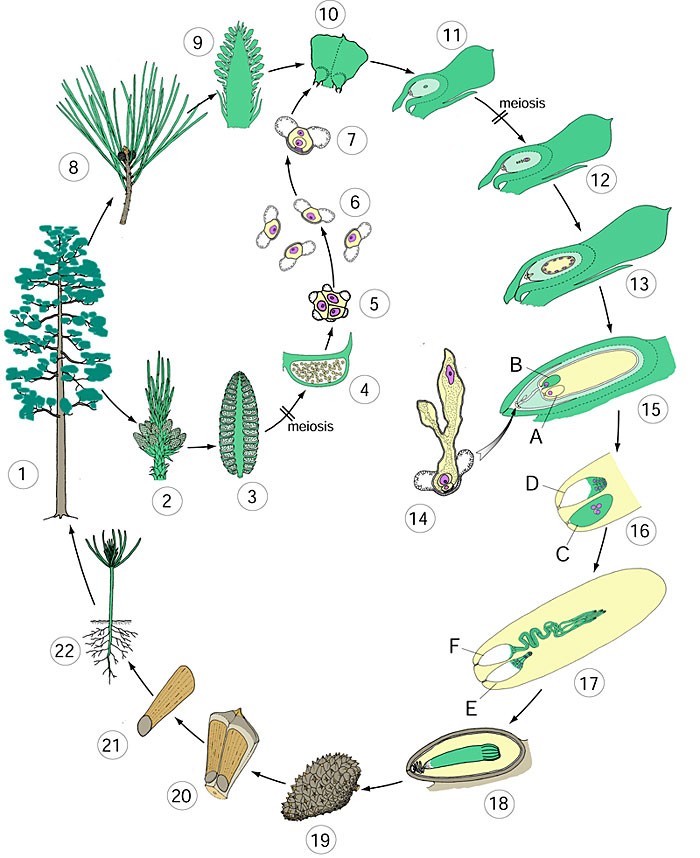
Details of the numbered stages:
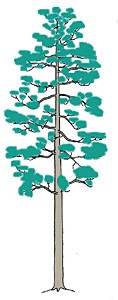
Stage 1: Male cones (pollen cones) and female cones (ovuliferous cones) are formed on the adult tree or the spore-bearing plant (sporophyte).
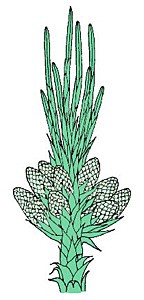
Stage 2: Several male cones are formed in a cluster beneath a new shoot.
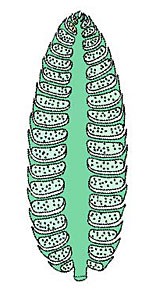
Stage 3: A longitudinal section of a male cone shows that it is made up of many fertile scales spirally arranged around a central stalk.
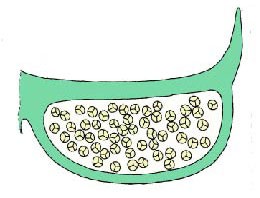
Stage 4: A longitudinal section through one fertile scale will reveal the contents of a pollen sac (there are two pollen sacs side by side on a fertile scale). Special cells called sporocytes inside the pollen sac undergo reduction division (meiosis) to form many small spores or microspores (Four microspores are formed from each sporocyte).
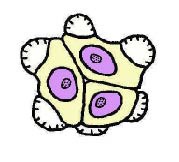
Stage 5: The single-celled microspores (still inside the pollen sac) begin developing into pollen grains while still attached to their fellow microspores. A thick wall forms around each developing pollen grain, and two zones of the wall bulge out and become hollow air-filled sacs.
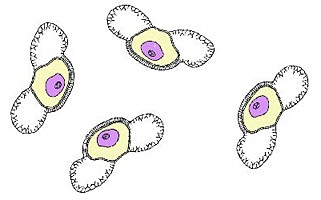
Stage 6: As they develop the microspores separate. Each microspore is a tiny single-celled haploid 'plant' genetically different from the parent plant.

Stage 7: When mature each microspore germinates. This means that it begins cell division. By the time of dispersal each pollen grain contains 4 cells inside a tough outer wall. These are the male gamete-forming ‘plants’ which are released from the parent sporophyte. The pollen grains are transported by air currents to reach the female cones of another tree.
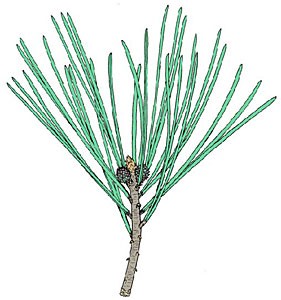
Stage 8: At the same time as the pollen cones form, female cones are formed near the tips of branches, often protected by surrounding leaves.
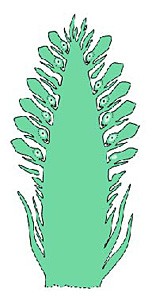
Stage 9: A longitudinal section of a female cone shows that it is made up of many fertile scales arranged spirally around the central stalk. At the time of pollination, the scales are slightly separated to allow pollen to fall between them to reach the ovules.
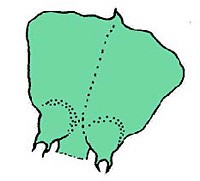
Stage 10: Each fertile scale has two ovules on its upper surface. Every ovule has a small opening in its integument, called the micropyle. Pollen grains are captured in watery droplets exuded by each ovule. The tiny air-filled sacs enable them to float up through the micropyle into the ovule to reach the surface of the female sporangium.
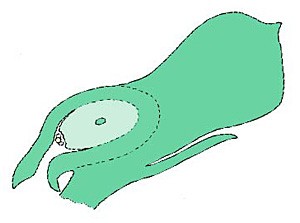
Stage 11: This shows a fertile scale cut longitudinally through one of the ovules. The ovule consists of a sporangium enclosed in an outer protective layer called the integument. A pollen grain can be seen on the exposed surface of the sporangium. At the centre of the sporangium is one special cell called a sporocyte.
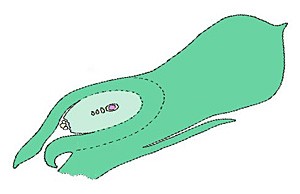
Stage 12: The sporocyte divides into four large haploid spores (megaspores) by reduction division (meiosis). Only one of the megaspores will remain functional. The other three abort and shrivel away.
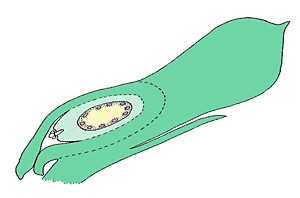
Stage 13: The functional megaspore now germinates to form a female gametophyte contained inside the ovule. The female gametophyte enlarges by multiple divisions of the nuclei, and the ovule enlarges to accommodate it. When it has attained full size the nuclei form cell walls. Eventually the female gametophyte is a multicellular structure several millimetres long inside the ovule.
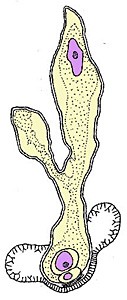
Stage 14: One of the cells inside the pollen grain divides into two sperm cells which travel along the pollen tube to reach an egg.
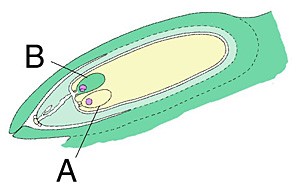
Stage 15: While lodged inside the ovule, the pollen grain has been growing a pollen tube through the sporangium tissue towards the egg-containing structures. Two egg-bearing structures (archegonia) form at one end of the female gametophyte. A fully mature archegonium contains one large egg cell (as in archegonium A). When a pollen tube reaches an archegonium it releases the two sperm nuclei into the egg. The first sperm nucleus to reach the egg nucleus will fertilize it. The fusion nucleus or zygote is the first cell of the next diploid spore-bearing plant (as in archegonium B).
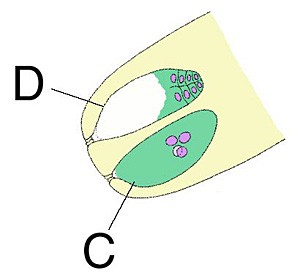
Stage 16: If two pollen grains entered the ovule at pollination, both archegonia may be fertilized. Stages 16 and 17 show four successive stages of development occurring in separate archegonia. The zygote divides into several nuclei which all move to the opposite end of the archegonium (as in archegonium C). Then they arrange themselves into four tiers of 4 cells (as in archegonium D).
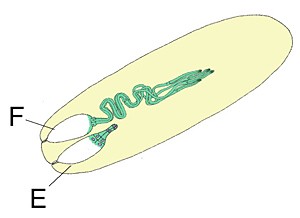
Stage 17: The end tier will become four embryo cells. The cells behind them begin to elongate and push the embryo cells out of the archegonium towards the middle of the female gametophyte (as in archegonium E). The elongating cells are called suspensors. As the four embryo cells are pushed deeper into the gametophyte they split apart into four separate embryos at the tips of four separate suspensors (as in archegonium F). The four embryos start to divide and eventually become multicellular. If two archegonia are fertilized this means eight embryos are formed. Only the most vigorous one will survive.
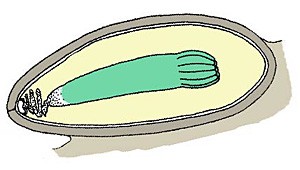
Stage 18: Once the elongating cells (suspensors) have completed their task they die. The surviving embryo enlarges as it forms a root tip, a shoot tip and several seed leaves (cotyledons). By now the surface tissue (integument) of the former ovule has hardened to form a seed coat, and the gametophyte tissue is packed with stored nourishment.
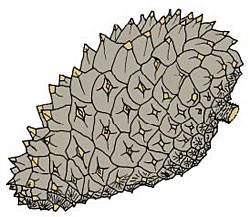
Stage 19: While the ovules have been developing into seeds, the entire female cone has become large and woody, with its scales tightly closed to protect the seeds inside.
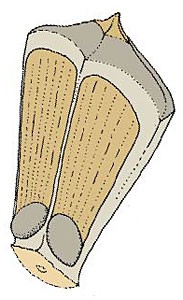
Stage 20: When fully mature the cones open to release the seeds. If both ovules were pollinated there will be two seeds formed on each scale.
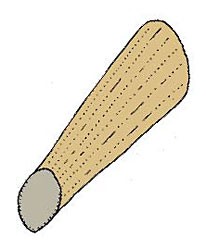
Stage 21: Attached to each seed coat is a papery wing, which enables the seed to be carried away from the parent tree by the wind.

Stage 22 Upon germination, a seed gives rise to a seedling with roots, stem and cotyledons.
